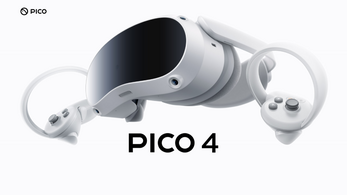Student's Choice - Pico 4
A downloadable project
This presentation/blog post/not-actually-a-game was made for the Student’s Choice Project of UIC’s CS428 course.
In this post, I will be covering the recently-released Pico 4, a VR headset created by its namesake company Pico. While the company has existed in the VR space as far back as 2015, it was only after its acquisition by Bytedance (well-known for being behind social app Tik Tok) in 2021 that they were able to start moving towards more serious attempts to compete in the VR market. Their latest attempt, of course, being the Pico 4.
Other VR products released by Pico in the past include the Pico G2 and Neo 3 series headsets. While both products have found limited success since their release, they have been mainly drowned out by market mainstays such as the Valve Index, HTC Vive, and of course the Meta Quest. And while the Neo 3 was intended to be Pico’s main competitor to the Meta Quest, the numbers haven’t been so kind.

Above, a chart from statista.com on worldwide XR headset shipment shares reveals that while the Neo 3’s release (May 2021) did bump up Pico’s sales by a considerable margin, it still pales in comparison to the domination that the Quest 2 has had on the market ever since it released back in October 2020. With this in mind, it’s no wonder when given new backing that Pico would step back up to the plate to try their hand once more at dethroning the king.
As for the Pico 4 itself, the headset was released on October 18, 2022 in various European countries, as well as some Asian countries such as Japan and Korea. As of writing, there have been no confirmed plans by Pico on a Western release date.

To the side, I’ve provided a table taken from roadtovr.com, directly comparing the specs of the Pico 4 to that of the Quest 2. Looking at the data, the Pico 4 seems to be on par with its competitor, even surpassing it in many cases such as the resolution, field of view, and RAM. Especially interesting about the Pico 4 is its use of Pancake lenses instead of the Fresnel lenses used in the Quest 2, which is what offers it such a large increase in field of view.

The Pico 4 isn’t without its drawbacks, however. It’s also important to mention that the Meta Quest has had a large amount of time to build a rather impressive catalog of games and software. Owing to the ubiquity of the Quest in the past few years, it’s rare to see developers that don’t develop with the Quest specifically in mind. The Pico 4 also lacks the breadth of accessories, 3rd party or otherwise, but it’s likely that problem will be solved as the headset gains traction and companies are given time to develop and release such peripherals.

For VR as a whole, the Pico 4 represents a new era for the industry. Ever since the Quest and especially the Quest 2 debuted it hasn’t faced much in serious competition. While there were clear competitors in terms of hardware such as the Valve Index, the sheer value the Quest 2 posed with its incredibly low price was simply too hard to beat. Since the Quest 2’s recent price increase, however, even that gap seems to be closing.
With the coming of the Pico 4, so do a number of “next-gen” headsets, such as the PSVR 2, Quest 3, and Apple VR headsets. For the VR industry as a whole, this new wave of competition for a market previously dominated by the Quest 2 represents a clear shift in how VR will be treated in the future. While VR has existed as a buyable product for a number of years now, it’s only recently that an actual push towards more consumer-friendly products has begun to appear.
In the past, VR has been widely regarded as a niche hobby, being both difficult and costly to get into, along with the general immaturity of the technology putting more than a handful of people off until it develops a little more. In that respect, the Quest 2 was a rather large step in that direction but went largely uncontested for a long period of time due to just how affordable Meta was able to make it. As competition rises, so will new innovations by all sides to try and get the average consumer to try out what was previously seen as something for only tech junkies. For the average consumer, this is only good news, as it means that prices will get cheaper and headsets will start to become even more advanced as larger companies such as Apple and Google begin to dip their toes in the VR market. With the advent of the Pico 4, as well as headsets to be released in the upcoming years, the future of VR looks to be quite bright, indeed.
Sources:
https://www.zdnet.com/article/pico-debuts-an-enterprise-specific-version-of-its-pico-4-headset/
https://www.protocol.com/bytedance-pico-vr
https://www.statista.com/statistics/1222146/xr-headset-shipment-share-worldwide-by-brand/
https://www.roadtovr.com/pico-4-announcement-release-date-specs-vs-quest-2/
https://www.youtube.com/watch?v=SNOB39F-Yak&ab_channel=RealiteVirtuelle܂com
https://www.roadtovr.com/best-oculus-quest-2-games-apps-rated-august-2022/
https://www.xrtoday.com/virtual-reality/most-innovative-vr-headset-vendors-to-wa...
| Status | Released |
| Category | Other |
| Author | Lunarium Works |

Leave a comment
Log in with itch.io to leave a comment.